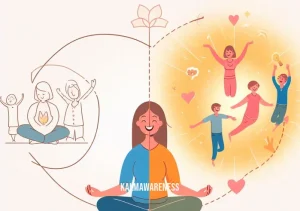Unveiling the Art of Meditating Face: Journey to Self-awareness and Stress Relief
Understanding and practicing the art of a meditating face is a critical step towards achieving mindfulness, self-awareness, and stress relief. This technique, steeped in age-old wisdom, integrates visualization and focused attention to promote relaxation and inner peace.
The Path to a Meditating Face
A meditating face represents tranquility, mindfulness, and a deep connection with one’s inner self. This state of serenity is not only achieved through physical relaxation but also through the cultivation of mental calmness. By learning how to master this art, you can tap into the power of mindful courage and deepen your awareness.
“Meditating face is not just about physical tranquility, it’s a profound journey of self-discovery and inner peace.”
The first step to developing a meditating face is understanding your pattern of thought and identifying any automatic negative thoughts. By recognizing these patterns, you can learn to channel your focus and check out your mind, encouraging a shift towards more positive, empowering thoughts.
Embracing Inner Calm
As you embark on this journey, you will need to confront your inner emotions, leaning into fear and embracing the full spectrum of human experience. This practice of inward emotional turbulence is crucial to achieving a truly meditative state.
You might encounter feelings of jealousy, anger, or fear along the way. But remember, these emotions are just part of the process. They’re stepping stones to achieving a state of mindfulness where you can observe without judgement, building resilience and emotional balance.
The Power of Visualization
Immersing yourself in beach guided imagery or a balloon meditation can help you visualize a calm, serene meditating face. Visualization is an effective technique for calming the mind and body, helping you to confront your emotions and achieve a relaxed state of being.
“Visualization is more than just a relaxation technique, it’s a powerful tool for achieving a meditating face, promoting deep relaxation and emotional balance.”
This journey towards a meditating face will challenge you to focus your attention and develop your mindfulness. But remember, you’re not alone. Renowned mindfulness expert Elisha Goldstein can guide you through specific mindfulness practices, including body scans and meditation techniques, to aid your journey.
As we conclude the first part of our journey towards the meditating face, you are encouraged to keep practicing and growing. Always remember the wise words, no matter where you go, there you are.
Up Next
Stay tuned for the next part of this insightful journey where we’ll delve deeper into the art of meditating face. We’ll explore the science behind mindfulness, unravel how meditation impacts your brain, and provide practical exercises to enhance your mindfulness journey. Discover how to truly master meditation and find your mindfulness intentions, creating a space of peace and serenity within yourself.

Mastering the Science of Meditating Face: The Neural Pathway to Mindfulness
As we continue our journey to mastering the art of a meditating face, it’s crucial to understand the neuroscience behind mindfulness. Meditation practices like this not only transform us emotionally and mentally, but they also bring about significant changes in our brain structures.
Neuroplasticity and Meditation
Our brain, an incredibly complex and dynamic organ, has the ability to rewire itself – a trait known as neuroplasticity. The practice of meditation can stimulate neuroplasticity, creating new neural pathways and modifying existing ones. By regularly practicing a meditating face, you’re training your brain to become more adaptable, improving its ability to manage stress and anxiety.
Dr. Michael Yellow Bird is a renowned researcher in the field of neuroscience and mindfulness. His work sheds light on how mindfulness techniques, including meditating face, can impact our neural structures, and subsequently, our mental and emotional health.
The Impact of Meditation on the Brain
Let’s delve deeper into the specific brain areas affected by the practice of meditating face:
Prefrontal Cortex
The prefrontal cortex, responsible for higher-order cognitive functions, undergoes significant changes with consistent meditation practice. This region plays a crucial role in decision-making, planning, and regulating emotions.
Amygdala
The amygdala, our brain’s fear center, shrinks in size with regular meditation. This reduction can lead to improved control over anxiety, stress, and fear.
Hippocampus
Meditation practices increase the hippocampus’ gray matter, responsible for memory and learning.
The following table presents a summary of these effects:
| Brain Region | Role | Impact of Meditation |
|---|---|---|
| Prefrontal Cortex | Decision-making, planning, emotional regulation | Enhanced functioning |
| Amygdala | Fear and emotion processing | Size reduction |
| Hippocampus | Memory and learning | Increased gray matter |
Techniques to Enhance your Meditation Journey
While understanding the science behind meditating face is crucial, it’s equally important to practice mindfulness and meditation regularly. Here are some methods to enhance your journey:
- Set clear intentions: Identifying your mindfulness intentions before starting each session can significantly improve your experience.
- Use guided meditations: Resources like Belleruth Naparstek’s guided meditation can help direct your focus and foster deeper relaxation.
- Practice mindfulness in daily activities: Incorporating mindfulness into everyday tasks, such as eating, can enhance your ability to stay present. Our mindful eating questions can guide you in this process.
- Create a dedicated meditation space: Having a specific location for meditation can facilitate a deeper connection with the practice. Decorate this space with calming mindfulness meditation images to enhance the atmosphere.
- Participate in mindfulness discussions: Engaging in mindfulness discussion questions can provide fresh perspectives and deepen your understanding of the practice.
As we conclude this chapter, remember the essence of a meditating face lies in regular practice, self-awareness, and compassion towards oneself. Let’s embrace this journey towards achieving mindfulness and embody the spirit of the saying, “Own the moment”.
In the next part of this article, we’ll explore the significance of visualization in meditation, and how it amplifies the practice of a meditating face. We’ll learn how to manage our inner emotions and lean into fear, facilitating a journey towards greater self-awareness and understanding.

The Power of Visualization in Cultivating a Meditating Face
A key ingredient in deepening the impact of a meditating face is the practice of visualization. It’s a powerful tool that transcends the boundaries of our conscious mind, offering a more vivid and experiential path towards mindfulness.
The Art of Visualization
Visualization is the act of creating compelling and vivid pictures in your mind. It’s an integral part of many meditation practices, including those focusing on a meditating face. Visualization allows us to engage more fully in the meditation process, moving beyond the cognitive level to a more experiential one.
Leveraging Visualization in Meditating Face
When you close your eyes to meditate, visualize your face softening and relaxing. See the tension melting away from your forehead, your eyes, your cheeks, and your mouth. This process of visualization can enhance the effects of the meditating face practice, fostering a deeper sense of calm and relaxation.
Guided imagery exercises like beach guided imagery and Belleruth Naparstek’s guided imagery for anxiety can aid in honing your visualization skills. These practices guide you to imagine calming scenarios or landscapes, helping to cultivate a peaceful mindset that complements the serene meditating face.
Moreover, techniques like the golden orb meditation involve visualizing a ball of golden light moving through your body, enveloping you in a sense of calm and positivity. This can enhance your meditation journey and help in mastering the art of a meditating face.
Embracing Your Inner Emotions
Visualizing a meditating face can also help us confront and manage our inner emotions. Instead of suppressing our feelings, we learn to acknowledge them, observing without judgment, a fundamental principle in mindfulness practices.
Remember, “No matter where you go, there you are.” This quote by Jon Kabat-Zinn reminds us that we carry our thoughts and emotions with us wherever we go. By practicing a meditating face, we learn to face these feelings head-on, with courage and acceptance.
Leaning into Fear
In our journey towards cultivating a meditating face, we may encounter obstacles in the form of fear or apprehension. Leaning into these fears instead of shying away from them can be a powerful catalyst for growth and self-discovery. As Rumi once said, “The wound is the place where the Light enters you.”
One specific technique to help lean into fear is leaning into fear meditation. This practice encourages us to face our fears, understanding them not as threats, but as opportunities for personal growth.
In conclusion, the practice of visualizing a meditating face enhances the depth and effectiveness of our mindfulness journey. By employing visualization, accepting our emotions, and facing our fears, we cultivate a deeper connection to our inner selves.
In the next part of this article, we’ll delve into the relationship between a meditating face and interpersonal mindfulness, exploring how this practice can transform not only our inner world but also our relationships with others. Stay tuned for insights on how to harness the power of meditation to build more meaningful connections and communicate mindfully.

The Interpersonal Dimension of a Meditating Face
Having explored the visualization techniques and introspective aspects of the meditating face, it is time to unfold its interpersonal dimensions. The calming aura of a meditating face not only brings tranquility to oneself but also radiates positive energy to those around us.
Interpersonal Mindfulness: A Closer Look
Interpersonal mindfulness, as discussed in this article, refers to the conscious effort to remain present in our interactions with others. It involves bringing the principles of mindfulness – such as attention, non-judgement, and acceptance – into our relationships.
Just as a meditating face helps us connect with our inner selves, it can also aid in enhancing our interpersonal connections. The tranquility and attentiveness reflected in our meditating face can encourage open and authentic communication, fostering stronger and more meaningful relationships.
“The greatest gift you can give someone is your attention.” – Jim Rohn
This quote encapsulates the essence of interpersonal mindfulness. By bringing our full attention to our interactions, we can truly understand and empathize with others, making them feel seen, heard, and valued.
Meditating Face and Non-Verbal Communication
| Element | Description |
|---|---|
| Facial Expressions | A meditating face often exudes calm and serenity, which can reassure others and facilitate open dialogue. |
| Eye Contact | A significant part of a meditating face, steady eye contact, can denote attention and respect, building trust in interactions. |
| Body Language | The body language accompanying a meditating face is often relaxed and open, which can make others feel comfortable and accepted. |
Cultivating a Meditating Face in Relationships
The practice of mindful courage can help us develop a meditating face in interpersonal contexts. This involves being present and responsive in interactions, even when they involve difficult conversations or emotions.
Furthermore, acknowledging that we are aware of awareness can deepen our interpersonal mindfulness. It means we are not only aware of our thoughts, feelings, and reactions but also mindful of this awareness itself, allowing us to respond rather than react in relationships.
“Vulnerability is the birthplace of connection and the path to the feeling of worthiness. If it were comfortable, it would not be vulnerability.” – Brené Brown
Brené Brown’s quote illustrates the power of vulnerability in building connections. A meditating face encourages us to embrace vulnerability, opening our hearts to ourselves and others, fostering deeper relationships.
In the end, a meditating face is not just about our individual journey towards mindfulness. It encompasses our interpersonal relationships, infusing them with presence, authenticity, and openness. As we embrace the meditating face, we can transform our connections, bringing a touch of mindfulness to all our interactions.
Join us in the next part of this article as we delve deeper into the transformative power of the meditating face. We will explore how this practice can help us confront and manage stress, leveraging mindfulness to foster resilience in the face of life’s challenges.

The Stress-Busting Potential of a Meditating Face
In our fast-paced world, stress is often an inevitable part of life. With the advent of an increasingly demanding lifestyle, managing stress has become more critical than ever. Enter the meditating face – a powerful, calming presence that provides an antidote to the turmoil of daily pressures.
The Science of Stress and Meditation
Stress initiates a cascade of biochemical reactions in our bodies, including the release of cortisol and adrenaline. These stress hormones prepare us for the ‘fight or flight’ response, causing increased heart rate, blood pressure, and glucose levels.
In contrast, a meditating face triggers the body’s relaxation response, a state of profound rest that decreases stress-induced reactions. Regularly maintaining a meditating face can regulate stress response, helping us become more resilient. Read more about this process in the article here.
A Meditating Face: Your Personal Stress-Relief Tool
- Physiological Benefits: A focused attention practice, such as maintaining a meditating face, relaxes the body, reducing muscle tension and slowing the heart rate.
- Cognitive Benefits: By directing our attention to the present moment, a meditating face helps us become more mindful, reducing automatic negative thoughts.
- Emotional Benefits: A meditating face encourages acceptance and non-judgment, assisting us in processing our emotions without getting overwhelmed by them.
“The greatest weapon against stress is our ability to choose one thought over another.” – William James
This quote by William James reminds us that we have the power to control our thoughts. A meditating face aids in exercising this power, leading us to a more peaceful and stress-free life.
Techniques to Achieve a Meditating Face
Various techniques can help you cultivate a meditating face, each with its unique set of benefits.
- Guided Imagery: Envisioning a peaceful place or situation can evoke a sense of serenity and calmness. Try out the Beach Guided Imagery or the Golden Light Meditation for a soothing experience.
- Mindful Breathing: Focusing on your breath brings your attention to the present moment, encouraging a relaxed and aware facial expression. You can explore more about mindful breathing here.
- Body Scan: This involves observing different parts of your body, including your face, to promote relaxation and mindfulness. Learn more about body scan techniques from Elisha Goldstein.
“In times of stress, the best thing we can do for each other is to listen with our ears and our hearts and to be assured that our questions are just as important as our answers.” – Fred Rogers
Fred Rogers’s quote beautifully encapsulates the role of empathy and understanding in stress management. Just as a meditating face is a manifestation of self-care, it also symbolizes our willingness to be there for others in their stressful moments.
Embarking on the journey of a meditating face, we invite tranquility into our lives, fostering an environment of mindfulness, compassion, and stress resilience. In the final part of this article, we will uncover how cultivating a meditating face can empower us to overcome challenges and embrace personal growth.

Empowerment Through a Meditating Face: The Key to Personal Growth
In the final chapter of this journey, we explore how adopting a meditating face can empower us, leading to significant personal growth and transformation. As you delve into the art of maintaining a meditative expression, you’ll find it to be a nurturing process, enabling you to discover your inner strength and resilience.
Manifesting Personal Strength Through a Meditating Face
Having a meditating face isn’t merely about stress relief; it’s a testament to your personal strength and control. This mindful expression becomes a symbol of inner peace and mental clarity, which fuels personal growth. It allows you to acknowledge your feelings without succumbing to them, giving you a sense of control over your emotional responses. You can find more insight on this topic here.
“The mind is everything. What you think, you become.” – Buddha
This quote by Buddha captures the essence of a meditating face perfectly. By focusing your thoughts on tranquility and peace, you gradually embody these qualities, ultimately impacting your personal growth.
Unleashing the Power of the Present
Maintaining a meditating face encourages us to live in the present moment, fostering a deeper connection with ourselves. This mindful connection is instrumental in personal growth as it provides clarity and insight into our behaviors, thoughts, and emotions. Mindfulness intentions serve as the foundation of this connection, guiding us on our path to self-discovery.
Growth Through Mindful Relationships
A meditating face doesn’t just influence our relationship with ourselves, but also with others. By practicing mindfulness, we are better equipped to communicate effectively, understand others’ perspectives, and maintain healthier relationships. These interpersonal skills play a pivotal role in personal growth. You can delve deeper into the concept of interpersonal mindfulness here.
“In the end, just three things matter: How well we have lived. How well we have loved. How well we have learned to let go.” – Jack Kornfield
In Jack Kornfield’s quote, we see the essence of personal growth reflected. A meditating face, as a practice of mindfulness, helps us live fully, love sincerely, and let go gracefully – three cornerstones of personal development.
Cultivating a Meditating Face: The Journey Ahead
As we conclude our exploration of the meditating face, remember that the journey doesn’t end here. Like any other mindfulness practice, cultivating a meditating face is a continuous process, where every step contributes to your personal growth.
By embracing a meditating face, you’re not just enhancing your ability to handle stress but also nurturing your capacity for growth, resilience, and self-realization.
In the spirit of continuous learning and growth, we encourage you to explore more topics on mindfulness and meditation on our website. Each article and resource is designed to support you on your journey towards inner peace and personal growth.
Thank you for embarking on this journey with us. We wish you success as you continue to cultivate your meditating face and discover the transformative power of mindfulness. Remember, the journey towards mindfulness is a rewarding one. Stay curious, stay mindful, and embrace the joy of growing mindfully.





